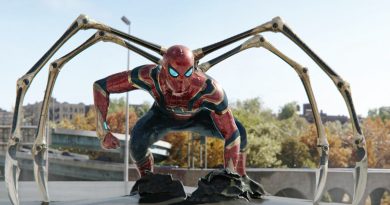Leatherface (2017) Review
In this prequel to 1974’s The Texas Chain Saw Massacre, young Jed (Boris Kabakchiev) is sent away by Sheriff Hal Hartman (Stephen Dorff) following a gruesome incident that caused the life of the sheriff’s daughter (Lorina Kamburova). Ten years later, the now-teenaged Jed along with three other patients and a young nurse (Vanessa Grasse) held as a hostage, escaped the mental institution. Soon, they find themselves being pursued by Sheriff Hal Hartman, who is looking for justice to exact revenge against his daughter’s death.
Been there, done that. Those are the words best described this unnecessary prequel to the late Tobe Hooper’s 1974 seminal horror classic, The Texas Chain Saw Massacre. Never mind the fact that Leatherface is heavily positioned as a direct or an official prequel to the aforementioned movie. In fact, Jonathan Liebesman has already done it once in The Texas Chainsaw Massacre: The Beginning. Although that 2006 prequel was pretty much a forgettable effort, at least Liebesman did it a mile better than the French directing duo Julien Maury and Alexandre Bustillo in Leatherface. Maury and Bustillo are, of course, best known for their blood-soaked debut in 2007’s Inside. The good news is, fans of their works will be pleased with their unflinching display of extreme gore and graphic violence seen in Leatherface. It certainly a dream come true for gorehounds, but that alone isn’t enough to justify the quality of this prequel.

Instead, the prequel is more like a monotonous exercise in all things nihilism. Apart from the gore and violence, Maury and Bustillo went as far as including a repulsive sex scene filled with necrophilia. But whatever so-called shock values they try to achieve here, the movie feels surprisingly lifeless and yet never scary.
The characters, in the meantime, are equally wasted. Most of them are as unlikeable as they get. Even the good sides like Stephen Dorff’s vengeful Sheriff Hal Hartman and Vanessa Grasse’s innocent nurse Lizzy White are reduced to thankless roles. Speaking of Vanessa Grasse, this is the first time I’ve seen an obligatory female victim in The Texas Chainsaw Massacre franchise falls flat to make me empathise or rooting for her outcome.
Then, there is Seth M. Sherwood’s screenplay which tries hard to keep things interesting by allowing us to guess “which of these characters are the grown-up Jed a.k.a. the one who will eventually become the chainsaw-wielding madman”. Unfortunately, the so-called whodunit or the guessing game here is all flash-in-the-pan gimmick. As mentioned earlier, most of the characters in this movie are unlikeable. So, why bother to care?

By the time the mystery surrounding Jedidah’s identity finally revealed and the inevitable chainsaw scene takes place during the final scene, it hardly matters anyway. The reason why the 1974 original became an enduring horror masterpiece until today is plain and simple. The Leatherface character is depicted as a disfigured, hulking monster who preys on his victims with a chainsaw. We know little about him. And that’s what makes him such a terrifying figure in the first place. Tobe Hooper understood the age-old concept that the fear of an unknown often works the best in creating a memorably scary character. By comparison, Maury and Bustillo alongside Sherwood made the same mistake as Liebesman and screenwriter Sheldon Turner did in The Texas Chainsaw Massacre: The Beginning: they made Leatherface a tragic figure.
Sadly enough, Leatherface would mark as the third movie in a row which failed to ignite the diminishing Texas Chainsaw Massacre franchise following the unsuccessful efforts of the 2006 prequel as well as 2013’s Texas Chainsaw.





